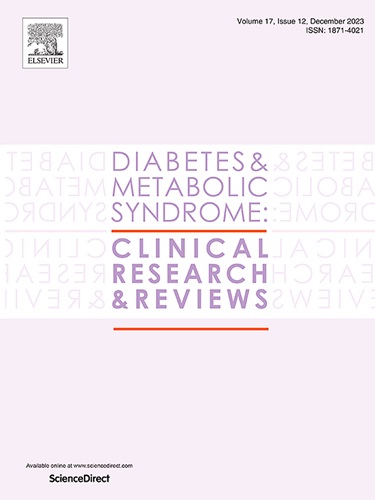ٍ食用黄栌对成人血压、血糖指数和身体成分的影响:经 GRADE 评估的系统综述和剂量反应元分析
IF 3.4
Q1 ENDOCRINOLOGY & METABOLISM
Diabetes & Metabolic Syndrome-Clinical Research & Reviews
Pub Date : 2024-09-01
DOI:10.1016/j.dsx.2024.103122
引用次数: 0
摘要
背景由于黄栌(Rhus coriaria L.,Anacardiaceae)含有丰富的植物化学物质,可能会影响血压、血糖和人体测量指数。因此,我们旨在通过对研究性临床试验进行荟萃分析,研究黄栌对这些因素影响的证据。方法在 PubMed/Medline、Scopus 和 Web of Science 上完成了截至 2024 年 1 月的系统文献检索。使用 I2 统计量对所选试验进行异质性检验。根据异质性检验结果评估随机效应模型,并以加权平均差(WMD)和 95 % 置信区间(CI)确定汇总数据。我们的研究结果表明,服用苏木可明显降低舒张压 (DBP) (WMD = -2.88 mmHg; 95 %CI, -4.22 to -1.54; P = 0.001)、空腹血糖 (FBG) (WMD = -5.15 mg/dL; 95 %CI, -8.73 to -1.57; P = 0.005)、胰岛素 (WMD = -1.95 uIU/ml; 95 %CI, 3.11 至 -0.79;P = 0.001)、血红蛋白 A1c(WMD = -0.48 %;95 %CI,-0.84 至 -0.12;P = 0.001)、胰岛素抵抗静态模型评估(HOMA-IR)(WMD = -0.71;95 %CI,-1.14 至 -0.27;P = 0.001)和腰臀比(WHR)(WMD = -0.01;95 %CI,-0.02 至 -0.00;P = 0.017)。结论我们发现,服用黄栌可改善DBP、血糖指数和WHR。此外,补充较高剂量或较长时间的这种草药对 FBG、HOMA-IR 和 WHR 有更大的影响。本文章由计算机程序翻译,如有差异,请以英文原文为准。
ٍEffects of Sumac Consumption on Blood Pressure, Glycemic Indices, and Body Composition in Adults: A GRADE-assessed Systematic Review and Dose-response Meta-analysis
Background
Owing to the rich phytochemical content of Rhus coriaria L. (Anacardiaceae), known as Sumac, it may affect blood pressure, glycemic, and anthropometric indices. We, therefore, aimed to examine evidence on effect of Sumac on these factors by conducting a meta-analysis of RCTs.
Methods
A systematic literature search up to January 2024 was completed in PubMed/Medline, Scopus, and Web of Science. Heterogeneity tests of the selected trials were performed using the I2 statistic. Random effects models were assessed based on the heterogeneity tests, and pooled data were determined as weighted mean differences (WMD) with a 95 % confidence interval (CI).
Results
Fifteen RCTs were included in this meta-analysis. Our findings showed that Sumac consumption significantly reduced diastolic blood pressure (DBP) (WMD = −2.88 mmHg; 95 %CI, −4.22 to −1.54; P = 0.001), fasting blood glucose (FBG) (WMD = −5.15 mg/dL; 95 %CI, −8.73 to −1.57; P = 0.005), insulin (WMD = −1.95 uIU/ml; 95 %CI, 3.11 to −0.79; P = 0.001), Hemoglobin A1c (WMD = −0.48 %; 95 %CI -0.84 to −0.12; P = 0.001), Homeostatic Model Assessment for Insulin Resistance (HOMA-IR) (WMD = −0.71; 95 %CI, −1.14 to −0.27; P = 0.001), and waist to hip ratio (WHR) (WMD = −0.01; 95 %CI, −0.02 to −0.00; P = 0.017). Sumac consumption had no significant effects on weight, body mass index, and waist circumference.
Conclusion
We found that Sumac consumption could improve DBP, glycemic indices, and WHR. Also, supplementation of this herb in higher doses or longer durations had more promising effects on FBG, HOMA-IR, and WHR.
求助全文
通过发布文献求助,成功后即可免费获取论文全文。
去求助
来源期刊

Diabetes & Metabolic Syndrome-Clinical Research & Reviews
ENDOCRINOLOGY & METABOLISM-
CiteScore
22.90
自引率
2.00%
发文量
248
审稿时长
51 days
期刊介绍:
Diabetes and Metabolic Syndrome: Clinical Research and Reviews is the official journal of DiabetesIndia. It aims to provide a global platform for healthcare professionals, diabetes educators, and other stakeholders to submit their research on diabetes care.
Types of Publications:
Diabetes and Metabolic Syndrome: Clinical Research and Reviews publishes peer-reviewed original articles, reviews, short communications, case reports, letters to the Editor, and expert comments. Reviews and mini-reviews are particularly welcomed for areas within endocrinology undergoing rapid changes.
 求助内容:
求助内容: 应助结果提醒方式:
应助结果提醒方式:


